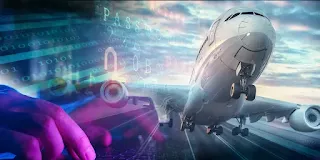Cyber Attacks on Planes: A Looming Threat to Aviation Security
The aviation industry has become increasingly reliant
on technology in recent years, from complex avionics systems to in-flight
entertainment and passenger Wi-Fi. While this technological advancement has
undoubtedly enhanced the passenger experience, it has also introduced new
vulnerabilities that cyber attackers can exploit. Cyber attacks on planes pose
a serious threat to aviation security, with the potential to disrupt flight
operations, compromise sensitive data, and even endanger the lives of
passengers and crew.
Notable Cyber Attacks on Planes
The history of cyber attacks on planes is not long, but
it is already marked by several significant incidents. In 2014, Air France fell
victim to a sophisticated attack that compromised its passenger reservation
system, causing widespread disruptions and flight cancellations. The attack was
attributed to a group of Russian hackers known as "Fancy Bear," who
are believed to have ties to the Russian government.
In 2015, a group called "Guardians of Peace"
targeted United Airlines, disrupting its website and causing delays and
cancellations. The group claimed they were retaliating against the airline's
participation in the NSA's surveillance program, which had been exposed by
whistleblower Edward Snowden.
More recently, in 2022, a low-cost airline in India
suffered a ransomware attack that encrypted its systems and forced the
cancellation of several flights. The attack was claimed by a group called
"REvil," who demanded a ransom payment in exchange for decrypting the
airline's files.
These are just a few examples of the growing threat of
cyber attacks on planes. As the aviation industry continues to rely more
heavily on technology, it is becoming increasingly important to develop robust
cybersecurity measures to protect against these attacks.
Investigations into Cyber Attacks on Planes
In response to the growing threat of cyber attacks on
planes, aviation authorities and law enforcement agencies around the world are
investigating these incidents in an effort to identify the perpetrators and
bring them to justice. These investigations can be complex and time-consuming,
as cyber attackers often operate from remote locations and use sophisticated
methods to conceal their identities.
One of the challenges in investigating cyber attacks on
planes is the lack of physical evidence. Cyber attacks often leave no trace of
their existence, making it difficult to identify the perpetrators and track
their movements. Additionally, cyber attackers may use proxies or other
techniques to mask their location and identity, further complicating the
investigation process.
Despite these challenges, law enforcement agencies have
made progress in investigating cyber attacks on planes. In 2016, the FBI
charged a Vietnamese hacker with cyber attacks on United Airlines and other
companies. The hacker was extradited to the United States and pleaded guilty to
the charges.
In addition to law enforcement investigations, aviation
authorities are also working to improve cybersecurity standards and
regulations. The International Civil Aviation Organization (ICAO) has developed
guidelines for cybersecurity in aviation, and many national aviation
authorities have adopted their own regulations. These regulations typically
require airlines and other aviation companies to implement cybersecurity
measures such as risk assessments, vulnerability scanning, and incident
response plans.
Cybersecurity Challenges in the Aviation Industry
Despite the efforts of aviation authorities and law
enforcement agencies, the aviation industry still faces significant
cybersecurity challenges. These challenges include:
- The increasing complexity of
aircraft systems: Modern aircraft are incredibly complex systems that rely
on a wide range of interconnected computer networks. This complexity makes
it more difficult to identify and secure all potential vulnerabilities.
- The interconnectedness of
aviation systems: Aircraft systems are not only complex, but they are also
interconnected with other systems, such as air traffic control and airline
reservation systems. This interconnectedness can make it easier for cyber
attackers to gain access to multiple systems with a single attack.
- The reliance on third-party
vendors: The aviation industry relies on a wide range of third-party
vendors for software and services. This reliance can introduce
vulnerabilities into aircraft systems, as vendors may not have the same
level of cybersecurity expertise as airlines and aircraft manufacturers.
Conclusion
Cyber attacks on planes pose a serious threat to the
safety of air travel. Aviation authorities, airlines, and law enforcement
agencies must continue to work together to improve cybersecurity measures,
investigate cyber attacks, and prosecute the perpetrators. By addressing the
cybersecurity challenges facing the aviation industry, we can help to ensure
the safety of our skies for generations to come.



